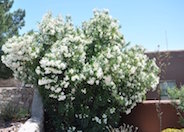
Common name:Oleander Sister Agnes
Botanical name:Nerium oleander 'Sister Agnes'
Nerium oleander 'Sister Agnes' is an evergreen shrub that grows at a fast rate to 20' tall. Leaves are narrow, dark green, leathery, and glossy. Blooms with single white flowers late spring through fall.
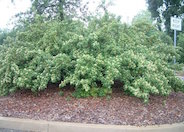
Common name:Red Clusterberry Cotoneaster
Botanical name:Cotoneaster lacteus
This is an evergreen shrub that grows to a size of 6-8' tall with long, arching branches. Cotoneaster exhibits dark green leaves above and gray beneath with dusky red fruit. It requires sun to part shade. Valuable for red berries and whitle flowers. This plant is tough enough to naturalize in many areas in CA, and should be considered potentially invasive.

Common name:Hollywood Twisted Juniper
Botanical name:Juniperus chinensis 'Kaizuka'
This conifer grows at a slow rate to 20' x 10'. It is a wild-looking tree that will give an artistic accent to any setting. It has an upright habit which includes broad, shrubby branches that spread irregularly but gracefully. Keep pruning to a minimum to enjoy this plant's natural beauty. Never use hedge shears.

Common name:Live Oak
Botanical name:Quercus virginiana
Large evergreen tree growing to 40' x 50' at moderate rate. Dark green leaves are leathery and toothed. Flowers are nonshowy and appear in the spring. Accepts lawn conditions. Consider mature size. Accepts full sun. Native to the southeast U.S.
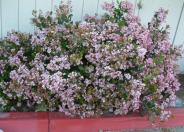
Common name:Indian Hawthorn
Botanical name:Rhaphiolepis indica
Indian hawthorn grow in a wide selection of heights, widths, and leaf textures – and bloom in white or a range of pink colors. Some Indian hawthorn have colorful darkened winter foliage and attractive berries, as
Indian hawthorn are not difficult to install properly. Select an area with full sun (at least 7 hours) and good airflow. Make sure that your sprinkler heads will not spray the leaves of your plants directly, just like a bed of roses or miniature crape myrtles. This discourages fungal leaf diseases from ever taking hold. Then just transplant your shrubs with the same compost, expanded shale, and greensand blend that you’d work into the soil when planting any common tree or shrub. Indian hawthorn have two notable maintenance quirks that must be observed for the best looking plantings! First, Indian hawthorn bloom off their older wood, so any major pruning or shaping of these plants should be saved until AFTER the shrubs bloom in the springtime. This allows your plants to have their best show of color. Secondly, Indian hawthorn when poorly maintained, can catch a fungal leaf disease called entomosporium leaf spot. Avoid this ever being a problem by making sure your plants get excellent sun, good airflow, good nutrition. Mature shrubs can reach 2-4' tall and 3-5' wide, depending on the cultivar.
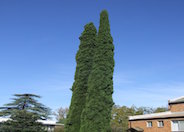
Common name:Italian Cypress
Botanical name:Cupressus sempervirens
Native to southern Europe, western Asia. With its narrow columnar habit of growth, this evergreen forms tall, dark green columns 40' to 60' in height. Leaves are dark green and scalelike. Can reach 3' to 10' wide. Does best in full sun. Established plants need little water. Tolerates most soil types as long as it's well draining. A fast growing tree that generally does not require pruning or maintenance. Dry conditions of the Southwest can cause problems with spider mites in early spring. If tree appears 'dusty', washing the tree down with a jet of water can help. This washing needs to be repeated five days later to control mites.
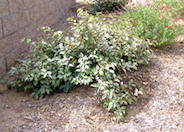
Common name:Fruitland Silverberry
Botanical name:Elaeagnus pungens
Evergreen shrub to 10-15' equally tall as wide. Through pruning you can keep it smaller. Large silvery leaves with rusty dots. Armed with spines. Good for hedge or dense barriers. Can be sheered; tolerates heat and wind. Tolerates bad soil.
Designer: David A. Grant
Photographer: GardenSoft
Physical weed control, including mulching, or hand removal protects the watershed from harmful chemicals.
Different areas of your landscape have different water requirements.
Shrubs need much less water than lawns and drip systems should never be scheduled on the same program with lawns.
Establish separate watering schedules for those areas.
Remove irrigation water and fertilizer from areas where you don't want weeds to grow.